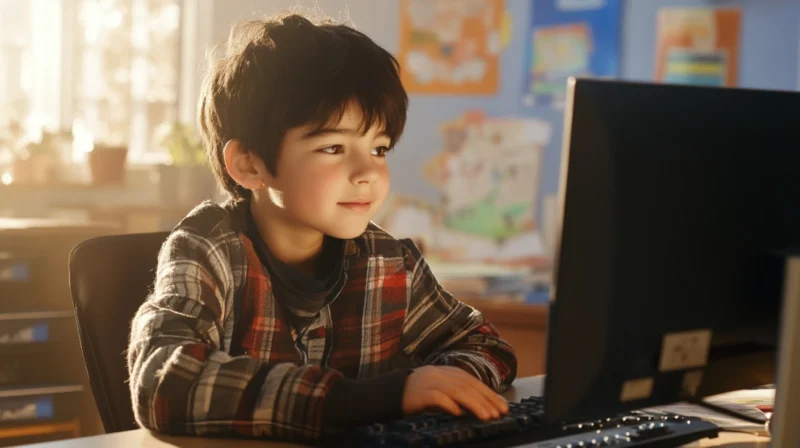
Share Post:
Education is transforming like never before.
For centuries, students have gathered in classrooms where a teacher stands in front and lectures.
This traditional approach has defined learning for generations, but a major shift is happening.
Enter blended learning.
Blended learning merges in-person teaching with digital technology, creating a more flexible and personalized learning experience.
It gives students greater control over how they learn while still benefiting from the guidance of a teacher.
In this article, we’ll explore ten key differences between blended and traditional learning.
Whether you’re an educator, a student, or simply curious, these insights will help you understand what sets these two approaches apart and what they mean for the future of education.
1. Learning Environment: Physical vs. Hybrid Spaces
Traditional learning occurs in a physical classroom where students gather to learn, listen, and interact.
The environment is fixed, structured with desks, whiteboards, and limited teaching aids.
Blended learning, however, combines physical spaces with online platforms.
Students can access learning materials from anywhere—at home, in a library, or even at a café.
This flexibility allows for a more adaptable and customized learning experience.
2. The Role of the Teacher: Instructor vs. Facilitator
In traditional classrooms, teachers serve as the primary source of knowledge.
They lecture, provide instructions, and maintain authority over learning.
Blended learning redefines the teacher’s role into a facilitator.
Teachers guide students through resources, answer questions, and provide personalized support as students explore content independently.
This allows students to take more ownership of their learning while receiving crucial mentorship.
3. Flexibility in Learning Pace
Traditional learning follows a fixed pace—students progress as a group, regardless of individual mastery.
Blended learning allows students to control the pace of their education.
Digital content can be revisited, paused, or accelerated based on individual needs.
This helps cater to different learning speeds, ensuring that no one falls behind or is held back by a rigid schedule.
4. Access to Learning Resources
Traditional classrooms rely heavily on textbooks, teacher notes, and limited supplementary materials.
Blended learning offers diverse resources, including videos, articles, simulations, and interactive exercises.
With information available online, students can explore topics in-depth, go beyond the syllabus, and engage with a wide variety of learning materials tailored to different learning styles.
5. Student Engagement: Passive vs. Active Learning
In traditional settings, students often engage passively—listening to lectures and taking notes.
Blended learning encourages active engagement.
Through interactive activities such as quizzes, online discussions, and multimedia content, students are more involved in the learning process.
Gamified elements in online modules can further enhance motivation, making learning a more dynamic experience.
6. Feedback: Scheduled vs. Immediate
In traditional classrooms, feedback is typically given after graded assignments or at specific intervals.
Blended learning provides continuous feedback.
Automated quizzes and digital assignments offer immediate results, allowing students to identify areas for improvement in real time.
Teachers can also give prompt feedback via online platforms, which helps keep students on track and informed about their progress.
7. Collaboration: Local vs. Global Interaction
Traditional classroom collaboration happens in-person, typically within small groups or the class as a whole.
Blended learning facilitates both local and global collaboration.
Online forums, group projects, and video conferencing tools allow students to collaborate not just with their peers but also with students from other locations.
This exposure to diverse perspectives enriches the learning experience and enhances students’ global awareness.
8. Technology Integration
Traditional learning often uses technology as a supplementary tool—like showing a presentation or playing an educational video.
In blended learning, technology is a central component. Learning Management Systems (LMS), digital simulations, and educational apps are integral to the learning process.
These tools not only deliver content but also create interactive, adaptive learning environments that enhance understanding.
9. Student Autonomy
Traditional learning follows a strict schedule where the teacher dictates what and when learning happens.
Blended learning emphasizes student autonomy. With access to online resources, students can choose when and how to study.
This fosters responsibility, time-management skills, and a proactive approach to learning, which are crucial for success in higher education and professional settings.
10. Personalization of Learning
In traditional classrooms, all students receive the same materials, lectures, and assignments. Personalization is often challenging given time constraints and class size.
Blended learning leverages technology to deliver personalized experiences.
Adaptive learning software adjusts the content and difficulty based on individual progress.
Teachers can use data from online platforms to identify students’ strengths and weaknesses, offering tailored support that enhances understanding and outcomes.
The Pros and Cons of Each Approach
Traditional Learning Pros:
- Structured environment with clear schedules.
- In-person interaction fosters a strong sense of community and social learning.
- Teacher-led classes provide consistent, guided instruction.
Traditional Learning Cons:
- Limited flexibility and slower pace for advanced learners.
- Uniform approach may not address all individual needs.
- Restricted access to a diverse range of resources.
Blended Learning Pros:
- Flexibility in pace and schedule, catering to different learning styles.
- Immediate, ongoing feedback aids quicker correction and comprehension.
- Access to global learning opportunities and varied resources.
- Increased student autonomy fosters independence.
Blended Learning Cons:
- Requires access to reliable technology and internet.
- Students must be self-disciplined to keep up with independent work.
- Teachers need training to effectively facilitate both in-person and digital components.
Conclusion
Choosing between blended and traditional learning depends on students’ and educators’ needs.
Blended learning is not about replacing traditional education but evolving it to incorporate technology and enhance learning experiences.
The future of education likely lies in hybrid models—combining the structure and direct interaction of traditional classrooms with the adaptability and personalization of blended learning.
Such a model promises to meet diverse needs, preparing students more effectively for a digital world where flexibility, critical thinking, and autonomy are key.
Related Posts:
- What is Quizlet and How to Use it to Create…
- How Group Exercise Can Boost Your Motivation and Results
- 8 Good Online Math Tutoring Websites for Kids and Students
- Top 10 Benefits of the Bodyweight Mastery Program…
- Intramural Sports - What They Are and How They Work
- 14 Hardest Calisthenics Exercises and How to Master Them











